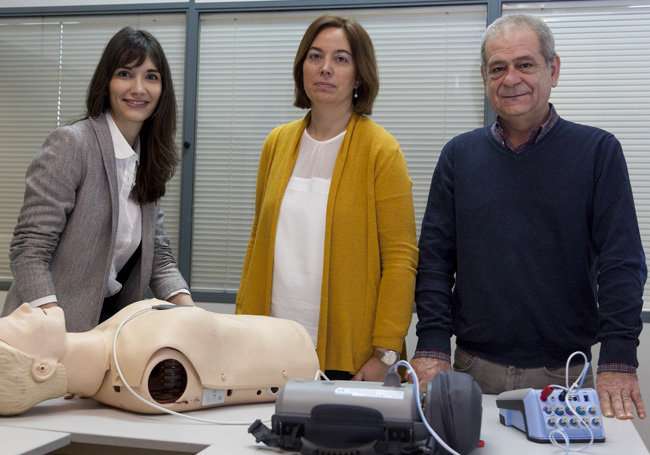A new algorithm designed to make cardiopulmonary resuscitation more effective

Researchers in the UPV/EHU's Signal and Communications Group in collaboration with researchers in the Oregon Health & Science University (OHSU) have developed an algorithm to guide an effective cardiopulmonary resuscitation manoeuvre. Based on chest acceleration, it calculates the depth and frequency at which chest compressions are performed. PLOS ONE reports on the research with a validation of the algorithm with acceleration signals recorded during actual instances of cardiorespiratory arrest.
In the event of a cardiorespiratory arrest, two actions are crucial for the patient's survival: cardiopulmonary resuscitation (CPR) and defibrillation. CPR consists of rhythmically compressing the patient's chest to generate a minimum flow of blood in order to minimise the deterioration of vital organs (heart and brain). And defibrillation involves applying an electric shock to try to reverse the arrhythmia. "It is essential to perform CPR properly for the manoeuvre to be effective, and that is not easy, even for highly trained personnel, since the chest has to be compressed at the appropriate frequency and depth (between 100-120 compressions per minute and between 5 and 6 cm)," said author Digna María González-Otero.
The quality of the compressions is related to the patient's survival. That is why the resuscitation guidelines recommend the use of feedback systems to monitor the quality of CPR in real time. "These devices are usually placed between the patient's chest and the rescuer's hands and guide the rescuer to help him/her achieve the target depth and frequency of the compression," said González-Otero. So researchers in the UPV/EHU's Signal and Communications Group have developed an algorithm to calculate the depth and frequency of the compressions on the basis of chest acceleration. "In other words," said González-Otero, "by placing an accelerometer on the patient's chest, we can measure, in real time, the depth and frequency at which the compressions are being performed, and then correct the rescuer if necessary so that he/she performs quality CPR."
The study validates the use of the new algorithm by demonstrating its accuracy in calculating the frequency and depth of the compressions when the acceleration signals measured in the chests of actual patients with cardiorespiratory arrest are analysed.
More information: Digna María González-Otero et al, Monitoring chest compression quality during cardiopulmonary resuscitation: Proof-of-concept of a single accelerometer-based feedback algorithm, PLOS ONE (2018). DOI: 10.1371/journal.pone.0192810
















